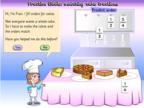Students use dynamic tools to solve problems involving fractions. Problems include comparison of the relative size of two fractions, the ordering of fractions from smallest to biggest and adding fractions.
Teacher notes
- Students first predict the answer to a problem involving fractions. They use a dynamic tool to solve the problem then see their problem-solving displayed in different formats.
- Visual, sound and textual feedback is provided, and guided support is provided to students experiencing difficulty. Students see the results of their problem solving in different formats including an area model, the fraction's position on a number line and the symbolic fraction.
- A notebook, which can be printed on completion of the task, automatically records the problems solved.
- Randomisation of the activities supports repeated use.
Learning objects
 |
Fraction fiddle: matching cake fractions |
 |
Fraction fiddle: hit the apple |